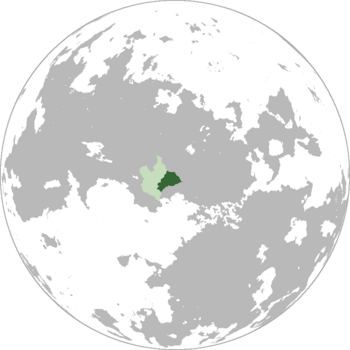Zhengia
This article is incomplete because it is pending further input from participants, or it is a work-in-progress by one author. Please comment on this article's talk page to share your input, comments and questions. Note: To contribute to this article, you may need to seek help from the author(s) of this page. |
|
Flag | |
| Motto: Better wisdom over power Zhengian: Lepшa mꝋdirozđ ponad siλu | |
| Anthem: Ode of wisdom | |
 Location of Zhengia (1930)
| |
| Capital | Ukadsk |
| Largest city | Kandan |
| Official languages | Bogmian |
| Ethnic groups | Zhengian Zaprei Phná |
| Demonym(s) | Zhoushi |
| Government | Federal Constitutional Republic |
• Prime Minister | Luanina Pusitin |
| Legislature | Zhengian Assembly |
| History of Zhengia | |
• Zhengian protokingdom | ~300 CE - ~700 CE |
• Independent Zhengia | 1665 CE - 1773 CE |
| 1773 CE - November 18th 1862 | |
• Zhengian Independence | January 3rd 1863 |
• Zhoushi Union | February 4th 1912 - May 8th 1925 |
| May 9th 1938 - September 5th 1941 | |
• Zhoushi Federation declared | September 6th 1943 |
• Mustelarian Federation formed | August 23rd 2017 |
| Area | |
• Total | [convert: invalid number] |
• Water (%) | 3 |
| Population | |
• 2020 estimate | 69,350,000 |
• 1936 census | 32,000,000 |
• Density | [convert: invalid number] |
| Currency | Zhengian Ijen Zhoushi Xailis (since 1923) |
| Time zone | UTC-4 (PMT) |
• Summer (DST) | UTC-4 (not observed) |
| Driving side | left |
Zhengia was a country, that formed a Union (1912) and later a Federation (1943) with Bogmia, creating the country of Zhousheng.
History
Expected migration period
The southern areas of Zhousheng called Zhengia were settled by Zhengs, which are linguistically descendants of Prei Means and Phnoms. Zhengian people migrated across the mountains from Prei Meas to southern Mustelaria in 1st century BCE. No records from 1st century about this migration can be found, therefore this part of the history relies on 5th century historical records from Zhengian Kingdom's scrolls (Old Zhengian dialect of Prei Mean: នគរហ្សេង (nokr hsae ng).
Bogmian integration
The Kingdom was conquered by Bogmians in about 800 AD and integrated into the Bogmian Empire. At this time, the old Zhengian started to give their way to the older Bogmian-Zhengian dialects, which dominated lower classes of most of the Zhengian states during the Dark Ages. Although linguistically shifting from Prei Mean root to Bogmian one, religion remains predominantly Kammist (Records from 1560 show, that although about 70% of recorded populace spoke some macaronic hybrid of Zhengian and Bogmian language, more than 90% of the populace were actively practicing Kammist religion).
Zhengian kingdom and The Empire of Three Kings
Zhengian Kingdom was formed in around 1720 CE and was quickly tied in a constant struggle over the culture. Zhengian language was actively dying as Zhengian intelligence was migrating to Bogmia, which was far more open to foreign ideals (Zhengian attempt to salvage the ancient Zhengian language backfired, because most of the intelligence felt oppressed by the draconic laws enforcing Zhengian language only). The Kingdom was integrated to the Empire of Three Kings after a civil war decimated their army and the victorious Jamgic (Standard Zhengian: ចាជី (cha chi), Bogemised Zhengian: ទ្ឝម្ត្ឝវ្ចិ (Dzhamzhovtsi) declared their intention on salvaging the Zhengian culture by integrating it with Bogmians, not by subjecting it to Bogmian. The era of the Zhengian presence in the Empire of Three Kings is seen as a quick pace of destruction of former Zhengian grammar, but salvation of their philosophy and culture and its proliferation across Bogmian territories.
Post-Imperial history
After the fall of the Empire, Zhengians tied themselves to new Bogmian state and formed a political Union by 1912. In 1915, Zhengians officially abandoned the old Prei Mean writing system in favor of the new Latin alphabet. After the War of the Council, Zhengians officially founded the Federation of Zhousheng with Bogmians, officially integrating Zhengian accents on the Macaronic language into the new Pan-Zhoushi dialects (which is a reason, why current Zhoushi alphabet has 40 separate phonemes, which is the most of any langauge from the whole of Anteria). During the Prei Mean civil war, Zhengian areas were heavily fortified by Zhoushi army and later used as a bridgehead in the involvement.
